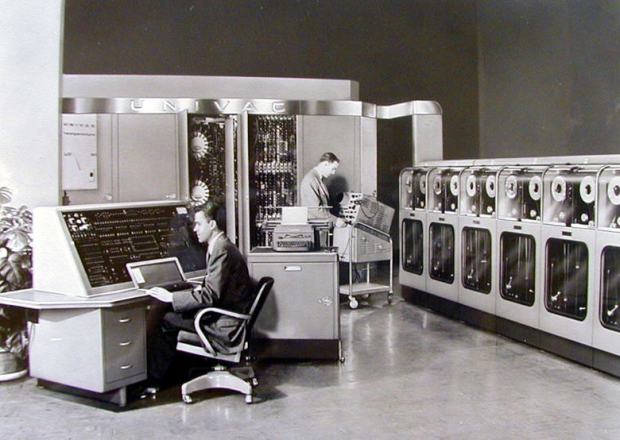If you think about it for a second, it’s inevitable. Let’s consider a single salient example. In 1951 there was a grant total of one commercial computer in operation in the world, the famous UNIVAC 1, and that was in the possession of the US government. It took almost a year to get it working properly. Concerning the future of computers, Thomas Watson, the-then IBM chairman, famously said in 1958: ‘I think there is a world market for about five computers.’ Surprise! In 2012 there are well over one billion in active service, far the greater part in the hands of individual citizens. What does this mean for the transport sector when it comes to planning, policy making and execution? What about Open Systems?
Most of the institutional structures and routines we have over the years created for planning and decision making in the transport sector are products of the thinking and the actions of the middle decades of the last century. In those good old days, the assumption was that all the smart people were on top and who better than they to make the best decisions for our transportation arrangements?
But hey!, life has moved on in many ways, and we now live in a very different era. In many parts of the world we have highly educated populations, meaning that there are many people out there who are not thus far directly involved in the planning and decision-making process who have valuable things to add to the policy and investment mix. This is the domain of the active citizen, those who are already getting directly involved in shaping their cities and the mobility arrangements they offer. (And it is this analysts guess that active citizenry is one of our most important growth sector, albeit invisible to most public authorities in most laces until now.)
But somehow despite all this distributed brainpower when it is time to take the big number decisions those taking them continue for the most part to ignore anyone outside of their own hierarchies and chosen expert sources — a situation that is made even more blatant by the for the most part largely unsuccessful not to say mediocre at best arrangements intended to make space for citizen input and participation.
Despite all the fuss that may be made about this “opening up” of the system in these various ways, for the most part that simply is not true. The system continues to be, let’s call it, “expert-based” and not citizen-based. Now this is a real problem and one of the reasons why so many poor decisions are taken and bad investments of scarce taxpayer money made in our field year after year.
What this boils down to is no less than a failure of 20th century democracy. That’s the bad news. but the good news is that this is now all behind us.
Let’s take a look at two contrasting examples.
To make my point let us take a look at a pair of images, which is easy to grasp and which can just as easily be extended to the entire process behind our decision making in the sector.
In a recent presentation to the China Academy of Transportation Sciences and the China Urban Sustainable Transport Research Center (CUSTReC) in Beijing , in the context of our in-process book project “The Third Transportation Revolution: A Tale of Cities, Indolence, Complexity and Equity”, we presented two pairs of visuals contrasting technology and performance advances in the field of transport in cities and “electronic transport”. They looked like this .
In 1951 New York City traffic looked like this.
And by 2011, it looked like this:
(I am sure you can see the differences.)
But let’s change focus and look at another sector spanning that same period:
In 1951 a computer looked like this. (Univac 1)
But by 2011, it looked like this:
Now, you may well ask, how does this relate to transportation in general and the concept of Open Data and Planning in particular. May we consider this by way of a bit of context:
The first UNIVAC I was delivered on June 14, 1951. The machine weighed 13 tons, occupied 25 feet by 50 feet of floor space, contained 5,600  tubes, 18,000 crystal diodes, and 300 relays. It utilized serial circuitry, 2.25 MHz bit rate, and had an internal storage capacity of 12k characters. Power consumption was about 120 kva. Reported processing speed was 0.525 milliseconds for arithmetic functions, 2.15 milliseconds for multiplication and 3.9 Milliseconds for division. Priced in 2012 USD ca. 13 million. In all 45 Univac’s were sold. All to the US government.
tubes, 18,000 crystal diodes, and 300 relays. It utilized serial circuitry, 2.25 MHz bit rate, and had an internal storage capacity of 12k characters. Power consumption was about 120 kva. Reported processing speed was 0.525 milliseconds for arithmetic functions, 2.15 milliseconds for multiplication and 3.9 Milliseconds for division. Priced in 2012 USD ca. 13 million. In all 45 Univac’s were sold. All to the US government.
The Ipad2 launched on 2 March 2011 weighed 652 grams, and measured 241.2  mm by185.7 mm, by 9.4 mm. Priced at ca. USD 500, the 2’s performance rivaled a four-processor version of the Cray 2 supercomputer, the world’s fastest computer in 1985. Apple reported more than one million 2’s were sold in the first weekend after launch. And it is probably safe to assume that not all were purchased by the US government.
mm by185.7 mm, by 9.4 mm. Priced at ca. USD 500, the 2’s performance rivaled a four-processor version of the Cray 2 supercomputer, the world’s fastest computer in 1985. Apple reported more than one million 2’s were sold in the first weekend after launch. And it is probably safe to assume that not all were purchased by the US government.
Conclusion
Education + capability + desire + tools = the basis for a new era of open data and open planning, which only in a few places have we even started to dig into.
But don’t worry, we will and soon.
# # #
Comments warmly invited directly here or if you prefer via World Street’s Facebook page at http://www.facebook.com/NewMobilityAgenda





I hope you are right about open data and open planning springing forth because of education + capability + desire + tools, but I note that the expertise to use powerful tools in powerful ways does not arise spontaneously or easily. About 20 years ago I was attending workshops on the bright future the (new) Internet would bring to ordinary citizens in support of their (expanded) participation in community, national, and world affairs and (increasing) contribution to collective expertise. However, as time has passed, many may agree with me that the capability to use the Internet in powerful ways for important public purposes is not yet widely dispersed in the general population. Put another way, the frontier of high capability is accelerating far ahead of average capability